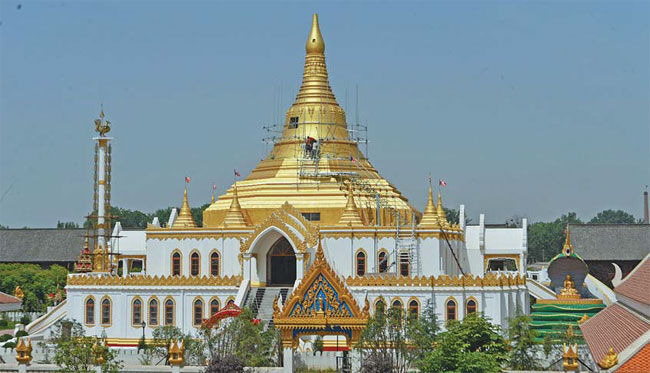 |
| The Myanmar Buddha hall is seen on May 29. It was inaugurated on June 30. GAO SHANYUE / FOR CHINA DAILY |
China's oldest Buddhist temple is becoming a channel to boost religious study and strengthen friendship across borders.
When graduate student Chen Xin visited the White Horse Temple in Luoyang of Henan province, she never expected to see shrines built in foreign styles there.
"The shrines were fabulous. We could experience exotic buildings and cultures. They also stimulated our interest to know more about Buddhism in these countries," said Chen, 30, from the Fourth Military Medical University.
The shrines at the White Horse Temple are built in the style of the Buddhist halls of India, Thailand and Myanmar. Myanmar President Thein Sein on June 30 inaugurated the Myanmar-style shrine, the latest one at the temple to be opened to the public.
Chen wished there were also Buddhists from these countries at the shrines whose activities would be able to give her a better idea and closer experience of their Buddhist culture.
Fortunately for devotees like her, more shrines in foreign styles are expected to be built in the White Horse Temple. The temple, established in AD 68, is considered the first Buddhist temple in China.
"We are trying to build as many shrines as possible in different styles and make full use of Buddhism as a channel to strengthen friendship with different countries," said Peng Yaping, director of Henan Administration for Religious Affairs.
According to an extension plan of the temple complex, more shrines or structures in foreign styles will be built in it by 2020. The International Buddhism Temple zone is expected to be large enough to accommodate another seven shrines or temples.
Following the Indian, Thai and Myanmar Buddha halls, the other foreign shrines will be funded by foreign governments, enterprises or religious groups. Several countries including Sri Lanka and Cambodia have expressed their interest in investing in similar programs.
White Horse Temple abbot Yinle said the private secretary of the prime minister of Sri Lanka has communicated with it regarding such investment and it is waiting for confirmation from the Sri Lankan authorities.
Wang Huijie, director of the Luoyang Administration for Religious Affairs, said there is also similar communication with Japan, the Republic of Korea and Nepal, with help from the Buddhist Association of China and scholars interested in Buddhism exchange.
Three students majoring in Buddhism from Thailand's Chulalongkorn University have arrived in the Thai-style shrine for a 10-month internship, Yinle said.
The Thai-style shrine, built in 1997 with 30 million yuan($4.83 million), is being extended and will be completed in September and reopened to the public soon after.
We recommend:
